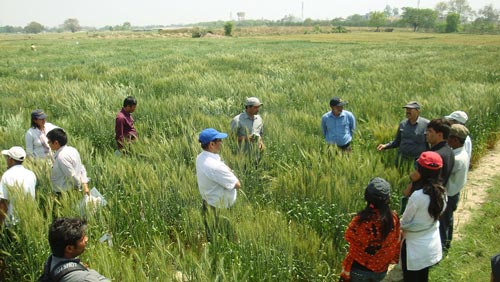 Spot blotch is one of the major diseases in the wheat growing regions of Nepal and the knowledge allowing researchers to identify and understand the disease is thus crucial. A group of 12 wheat technical research staff from Nepal visited Banaras Hindu University (BHU) in Varanasi, India, during 18-21 March 2013 with that purpose exactly: to learn more about the spot blotch disease and participatory varietal selection. The training was coordinated by CIMMYT wheat breeder Arun Joshi under the CRP WHEAT Strategic Initiative 5: durable resistance and management of diseases and insect pests. The main resource persons for the training were Ramesh Chand, Vinod Kumar Mishra, and B. Arun; Naji Eisa (Yemen), Conformt Sankem (Nigeria), Chhavi Tiwari, and Punam Yadav (India), all PhD students from BHU, facilitated the program.
Spot blotch is one of the major diseases in the wheat growing regions of Nepal and the knowledge allowing researchers to identify and understand the disease is thus crucial. A group of 12 wheat technical research staff from Nepal visited Banaras Hindu University (BHU) in Varanasi, India, during 18-21 March 2013 with that purpose exactly: to learn more about the spot blotch disease and participatory varietal selection. The training was coordinated by CIMMYT wheat breeder Arun Joshi under the CRP WHEAT Strategic Initiative 5: durable resistance and management of diseases and insect pests. The main resource persons for the training were Ramesh Chand, Vinod Kumar Mishra, and B. Arun; Naji Eisa (Yemen), Conformt Sankem (Nigeria), Chhavi Tiwari, and Punam Yadav (India), all PhD students from BHU, facilitated the program.
The training covered identification of spot blotch pathogen Bipolaris sorokiniana in the field and the lab; preparation of Bipolaris inoculum using colonized sorghum grain; understanding the spot blotch disease infection process; creating artificial epiphytotic in the polyhouse and the field; screening wheat genotypes under high humidity and temperature in the polyhouse; recording disease severity in field and polyhouse conditions; and increasing data reliability in research on spot blotch of wheat and barley.
Participants first visited the pathology laboratory in the Mycology and Plant Pathology department, where they learned to identify B. sorokiniana under the microscope and to prepare Bipolaris inoculums from colonized sorghum grain. The infection process was explained using different samples available in the lab, as was a new technique for evaluation of spot blotch resistance in barley and wheat using monoconidial culture of the most aggressive isolate of B. sorokiniana developed at BHU. Participants observed the collection of the blotched portions of infected leaves for the production of conidia by associated fungal hyphae. They were also trained in conidia collection for further multiplication and categorization into different classes based on the aggressiveness of isolates.
 On the second day, participants visited the polyhouse and research station to learn about screening wheat genotypes
On the second day, participants visited the polyhouse and research station to learn about screening wheat genotypes
under high humidity and temperature. They recorded the disease severity a number of times and saw that if inoculation is done properly the susceptible genotypes burn. The variation among genotypes for resistance to spot blotch disease was explained with the help of repeated disease notes and developing area under disease progress curve. Participants also observed the CRP project on spot blotch carried out at BHU in collaboration with the Nepal Wheat Research Program. The visiting team fruitfully interacted with the BHU wheat researchers, especially with Chand and Mishra, as well as with master’s and doctoral students working on spot blotch. A planned one-hour question-and-answer session expanded to three hours due to the visitors’ enthusiasm and wide-ranging questions.
On their final day, the team visited three participatory varietal selection sites where Harikirtan Singh, the lead farmer, demonstrated the performance of the most popular and newly developed lines under different seeding conditions (surface seeding, zero tillage, and conventional tillage) and multiplication of a number of agronomically superior zinc-rich wheat lines selected from the HarvestPlus project.
The training also allowed participants to visit other research experiments and trials associated with the Cereal System Initiative South Asia (CSISA) and HarvestPlus projects, and to learn to identify agronomically superior biotic and abiotic resistant varieties.
The Nepalese team regarded the visit highly successful as it provided an excellent opportunity to work with the most recent tools and techniques in spot blotch and other wheat researches and to enrich their experience on proper data recording and conduct of participatory varietal selection trials.
 Climate adaptation and mitigation
Climate adaptation and mitigation 
